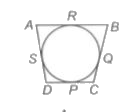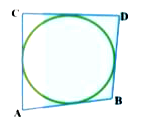In the given figure, a circle touches all the four sides of a quadrilateral ABCD whose three sides are AB = 6 cm, BC = 7 cm, CD = 4 cm, then AD equals ______

10 cm
13 cm
11 cm
3 cm
The correct Answer is:D
Step by step video & image solution for In the given figure, a circle touches all the four sides of a quadrilateral ABCD whose three sides are AB = 6 cm, BC = 7 cm, CD = 4 cm, then AD equals ______ by Maths experts to help you in doubts & scoring excellent marks in Class 10 exams.
Updated on:21/07/2023Topper's Solved these Questions
- CIRCLESBOOK - SCIENCE OLYMPIAD FOUNDATION CHAPTER - CIRCLESEXERCISE - ACHIEVERS SECTION (HOTS)
5 Videos
- ARITHMETIC PROGRESSIONS BOOK - SCIENCE OLYMPIAD FOUNDATION CHAPTER - ARITHMETIC PROGRESSIONS EXERCISE - ACHIEVERS SECTION (HOTS)
5 Videos
- CONSTRUCTIONSBOOK - SCIENCE OLYMPIAD FOUNDATION CHAPTER - CONSTRUCTIONSEXERCISE - Achievers Section (HOTS)
5 Videos
Similar Questions
Knowledge Check
In the figure, a circle touches all the four sides of a quadrilateral ABCD whose sides AB= 6.5 cm, BD= 5.4 cm and CD = 5.3 cm . The length of AC is :
 A4.6 cmB5.8 cmC6.2 cmD6.4 cm
A4.6 cmB5.8 cmC6.2 cmD6.4 cmAll sides of a quadrilateral ABCD touch a circle. If AB=6cm,BC=7.5cm,CD=3cm, then DA is
A3.5 cmB4.5 cmC2.5 cmD1.5 cmIf the sides of a quadrilateral ABCD touch a circle and AB = 6 cm, CD = 5 cm, BC = 7 cm, then the length of AD in cm is :
Aa) 8Bb) 9Cc) 4Dd) 6
A circle touches all the four sides of a quadrilateral ABCD. Prove that AB + CD = BC + DA
View SolutionA circle touches all the four sides of a quadrilateral ABCD. If AB = 9 cm, BC= 8 cm and CD = 12 cm, then what is DA equal to?
View SolutionIf circle touches all the sides of a quadrilateral ABCD, if AB = 7 cm, CD = 3 cm, BC = 8.5 cm. Find the length of AD.
View SolutionIn Fig. 10.54, a circle touches all the four sides of a quadrilateral ABCD with AB=6cm , BC=7cm and CD=4cm . Find AD . (FIGURE)
View SolutionA circle touches all the sides of a quadrilateral PQRS, whose sides. PQ=2cm, QR =3cm and RS= 4cm. What is the length of PS?
View Solution
